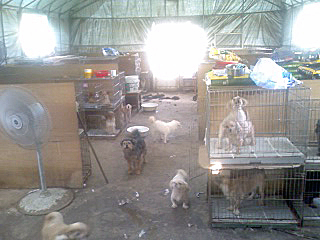![]() Latest News
Latest News
The Shelter Gap
Stray animal management lacking in South Korea
[Editor's note: This article was written in September 2007. As of June 2008, due to the diligent efforts of many hardworking foreign volunteers, the Daejeon shelter has successfully decreased its dog population from around 200 to 86. More than 100 animals have been successfully adopted. Also due to their work, Ms. Jung's eviction notice has been postponed until June 30th, 2008. For more info visit http://www.animalrescuekorea.org/]
IAKA has identified 32 impromptu shelters throughout South Korea housing anywhere from 30 to 1600 dogs. These are shelters created for strays by private persons out of concern for the well being of the animals. Good intentions do not necessarily amount to clean and well-managed shelters, however, and some operate in a frightful state.
In Daejon City, South Korea lies such a shelter which was brought to IAKA’s attention by a compassionate English teacher living in the area. It is composed of two vinyl greenhouses, one acting as both an exercise area for the shelter’s 200 resident dogs and as a home to Ms. Jung Nanyoung. Ms. Jung shows all the characteristics of an animal hoarder: she cannot provide a minimal standard of care, she is in denial of her failure to do so and yet she continues to bring in more animals. Ms. Jung is in poor health and subsists on a monthly income of $400 in government welfare payments.
A television broadcast exposing the situation aired a few years ago. A torrent of support followed. People donated money, supplies, veterinary care and even identified better facilities to house the dogs. In the end nothing improved; the shelter remained in the same appalling state and the public assistance all but evaporated. “Mango Mom,” a woman operating a much healthier shelter in Daejon, continues to make donations of food solely out of sympathy for the animals.
Not only does Ms. Jung’s shelter provide the dogs a bad living environment, but her 2-year lease on the property has expired, and she has repeatedly ignored eviction notices. The local government fined her for illegally keeping the dogs on land not designated for this use, and resolved to close the shelter and evict her by the end of last year. It would have been impossible to find new homes for this number of dogs on such short notice, so mass euthanasia was being seriously considered.
The possibility of such an outcome sparked an international outcry, mobilizing animal lovers to find a better solution. A proposal asking the Daejon City Council to postpone the deadline by 4-6 months was sent in. This extension would provide ample time to perform health checks, give the dogs vaccinations, and find them new homes. Encouraged by the successful rehoming of 30 dogs in one month, the City Council has indicated that it is looking favorably at the proposal. IAKA, among others, is financially supporting the feeding, veterinary care, transportation, and adoption of these dogs.
Ms. Jung’s shelter, like all of South Korea’s private shelters, arose to fill a gap left vacant by both the government and NGOs. Shelter options are lacking, and so is proper education and training. IAKA recognizes the immediate need for stray animal management and plans to educate private shelter owners on animal care and general operations as part of its new Education Campaign with KAPES.





